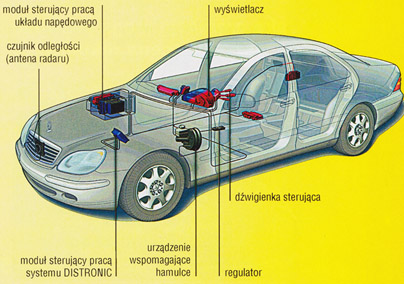 The congestion and rapidly changing driving conditions on the highways made it, that the use of traditional cruise control began to lose sense, and even became dangerous. Manufacturers' recommendations, so as not to use them in dense traffic, on slippery surfaces and winding roads, were no longer enough. Devices are the answer of the designers, combining the functions of maintaining a constant speed with keeping the appropriate distance from the vehicle in front. This is accomplished via radar (or using infrared radiation) assessment of the distance between moving objects. Located behind the radiator air inlet cover, the transceiver module sends central heating 1-2 s beam of waves
The congestion and rapidly changing driving conditions on the highways made it, that the use of traditional cruise control began to lose sense, and even became dangerous. Manufacturers' recommendations, so as not to use them in dense traffic, on slippery surfaces and winding roads, were no longer enough. Devices are the answer of the designers, combining the functions of maintaining a constant speed with keeping the appropriate distance from the vehicle in front. This is accomplished via radar (or using infrared radiation) assessment of the distance between moving objects. Located behind the radiator air inlet cover, the transceiver module sends central heating 1-2 s beam of waves
with a frequency of several dozen GHz and a range of approx. 150 m, diverging at an angle from a few to several degrees. After hitting an obstacle, the beam reflects off it and returns to its source, however, already with a changed frequency. Based on this difference, according to the Doppler effect, a high-speed microprocessor calculates the relative speed of the two cars and the distance between them (the data appears on the display). If the control system finds, that the distance to the vehicle in front is too short, automatically closes the throttle or activates the braking system. When this is not enough, warns the driver with an acoustic and light signal of the danger, making him aware of the need for decisive interference. The system therefore does not relieve the driver of responsibility for developments on the road, allowing him only to concentrate more on driving and increasing the level of traveling comfort. It works in the speed range in between 40 a 160 km/h. An additional sensor that detects the curvature of the curve and corrects the direction of the wave emission from the radar allows it to function properly when cornering.. Engineers also had to deal with the problem of unambiguously distinguishing between dynamic and static obstacles and maintaining measurement precision in fog and rain. Ready solutions are already offered, m.in. Jaguar (Forewarn Adaptive Cruise Control developed by Delphi for the XKR model) i Mercedes (Distronic in the S-class models).
